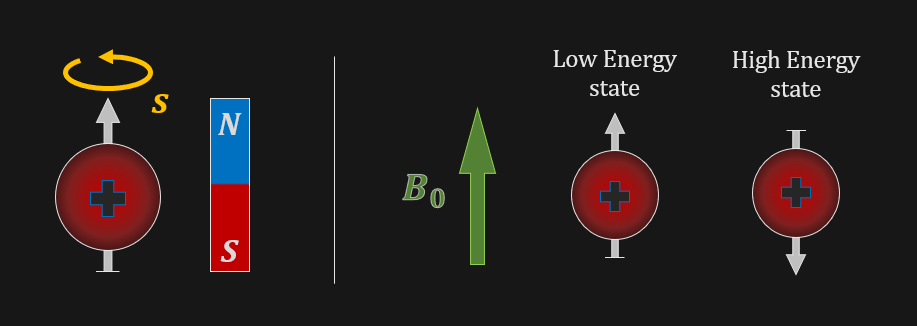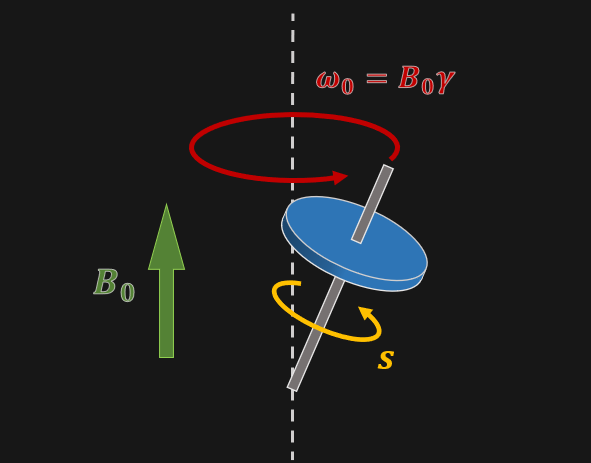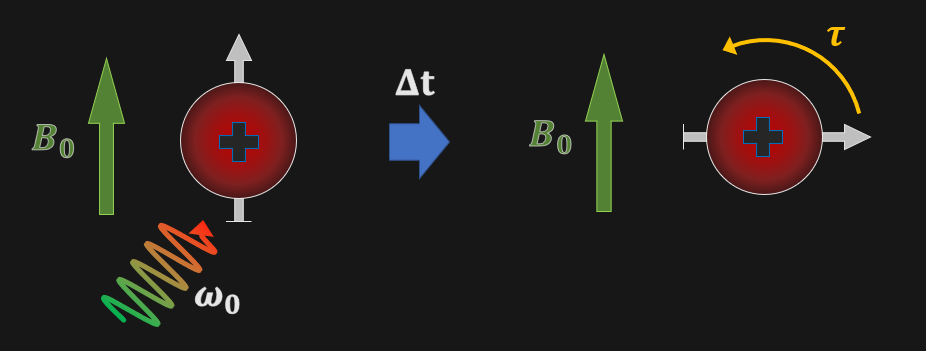dear fellows long time no see!
Before talking about the gradient coils (the point of the next log) I'm going to explain briefly and not in too much detail the theory behind MRI.
Magnetic properties of Protons
Ok, let's start with some basic concepts. Protons (hydrogen atoms) have an intrinsic property called Spin. This gives the proton magnetic properties like a small magnet.

Now think of all the water molecules that are in our body, in a normal state where there is no magnetic field around, protons are randomly oriented resulting in a net zero magnetization. Suppose we apply some magnetic field like a big magnet, protons are going to align with it. Imagine it's like a little magnet on a table if we place nearby a strong magnet the first will align and attach to the latter.

Not all protons align with it or to be more clear it can be in two states: parallel where protons align in the same direction of the external field or antiparallel direction. The first one is preferred because it has a lower energy state than the antiparallel one. Think of two magnets with the same polarity, you need a lot of force to squeeze them together like you need 'higher energy', if we flip one of them they will automatically snap together (low energy).
For these reasons more protons will align in a parallel state, thus resulting in a net magnetization in the forward direction. if the population of parallel and antiparallel is 50%-50% their magnetization cancels out like adding and subtracting. The stronger the external magnetic field the higher will be the population of parallels with respect to antiparallels protons and the bigger will be the net magnetization. To achieve this, modern MRI produces a magnetic field in the order of 7-8 Tesla that is like 100k times stronger than that measured on the surface of the earth (65uT).
Precession
Now that we have magnetized our body, the image comes from the non-uniform density of water in our different tissues (bones, skin, muscles, ... ). We need some way to measure this density and produce the image we need. To achieve this we need to use an antenna that produces a precise radiofrequency wave.
Why?
Well, when protons, that possess spin, are immersed inside a static magnetic field, exhibit a phenomenon called precession, it behaves like a gyroscope.

if we rotate the proton from the direction of the main magnetic field it starts to precess. This happens because the main magnetic field forces the proton to realign but the proton has an angular momentum from the spin that prevents the alignment. Consequently, an apparent rotation appears around the axis of the main magnetic field. Gyroscopes have an analogous behavior, you can check Prof. Walter Lewin from MIT in one of his lectures about angular momentum.
The frequency at which the proton precess depends on the magnetic field intensity and the gyromagnetic constant (intrinsic property which differs atom by atom), described by the Larmor equation:
Our body as Radio Transmitter
Now the answer to the previous question: why do we need an antenna? well, the goal is to rotate 90deg away from the main direction which from now on I will call "z", we send an electromagnetic wave to the proton with the same frequency given from the Larmor equation. The EM wave gives a "push" at the right time while the proton precess ( I'm oversimplifying a lot here, maybe I'm going to explain this in more detail in another log )

After some time the proton has a rotation of 90deg respect to z so we stop transmitting. In this situation, the proton feels the torque from the magnetic field to realign in the z-direction. So the proton precess back and in doing so, another electromagnetic wave is generated but this time from the proton itself.

We receive this signal (with another antenna as we do for a radio or television). Where the tissue has higher density it produces bigger signal intensity because more protons generate a wave.
Gradient coils
There is one problem, we don't know what proton in space produced this signal so we have no clue about its positions and it's impossible to generate an image. So far all protons have had the same magnetization. The trick is to vary the external field in space.

If we add another external field that changes in space the resulting total magnetic field is no longer uniform in space. Every proton sees a different magnetic field so precess at different speeds that result in a different frequency of the emitted signal. In this way, we know where that signal came from space and we can assign at each pixel in our image the appropriate intensity.
To produce this varying field we need something called Gradient Coil. In the next log, I'll explain how I simulated and started to build this piece.
 Davide Ruzza
Davide Ruzza
Discussions
Become a Hackaday.io Member
Create an account to leave a comment. Already have an account? Log In.